Bulletin – September 2016 Global Economy Chinese Household Income, Consumption and Savings
- Download 356KB
Abstract
Household income and spending in China have grown rapidly over the past few decades, and income inequality has also risen. The various measures of China's aggregate household saving rate have all increased since the 1990s, and variation in saving behaviour by income group suggests that increasing the income of poorer households in particular would boost aggregate consumption. Changes in Chinese household consumption patterns as incomes rise have the potential to lead to higher imports of services and food from Australia in the long run. However, uncertainty around the outlook for growth of Chinese household income, consumption and saving is increasing as economic growth moderates in China.
Introduction
China has experienced rapid growth in household income over recent decades. This has been accompanied by both strong consumption growth and a large rise in the saving rate (Graph 1).[1] The increase in household income has not been evenly spread, however, and income inequality has risen significantly. This article discusses why income inequality has increased and some of the possible implications, with a focus on differences in saving and consumption behaviour across the income distribution. Measures of China's aggregate household saving rate are discussed, and reasons for the increase in these measures over the 1990s and 2000s are outlined. We also examine the changing trends in consumer spending and the effect these might have on Chinese demand for Australian exports.
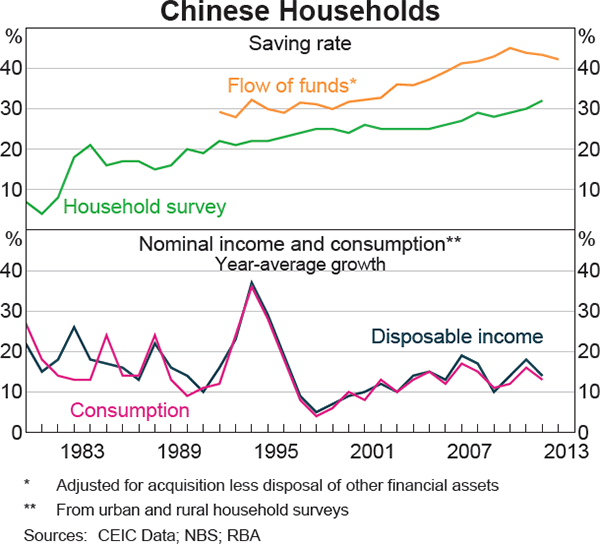
Income Distribution
Income is a key determinant of households' consumption and saving behaviour. If households' propensities to consume and save vary with income, then aggregate consumption and saving at any point in time will depend on the distribution of household income. In addition, changes in the distribution of household income over time will affect the growth rates of aggregate consumption and saving, relative to what they might have been had the distribution of income remained unchanged.
Over the past two decades, real household incomes in China have averaged annual growth of 10 per cent, but this rapid growth has been accompanied by a notable rise in income inequality. In China, the Gini coefficient – a commonly used measure of income inequality – rose from a relatively low level of around 0.3 in the early 1980s to 0.5 in the mid 2000s (Graph 2).[2] Since 2009, China's Gini coefficient has declined a little, but it remains in the top quintile worldwide.[3] The rise in inequality has not reflected a stagnation of incomes for the poorest households, but has instead been due to wealthier households seeing even stronger income growth. Rural incomes have grown strongly through most of the period since the 1990s, as have incomes of poorer households in urban areas. The World Bank has estimated that the proportion of Chinese living in poverty declined from 67 per cent in 1990 to 11 per cent in 2010.[4]
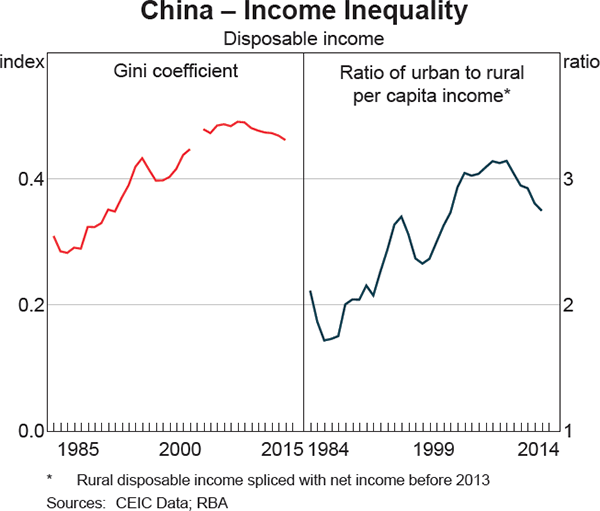
One of the key reasons cited for the rise in national measures of income inequality in China since the 1980s is a widening of the urban-rural income gap. The World Bank estimates that this income divide explained around 40 per cent of overall income inequality in the early 2000s and around half of the increase in inequality between 1985 and 1995 (Park 2008). In the mid 1980s, average urban disposable income was less than twice rural income; by 2010 that ratio had increased to more than three times (Graph 2). The gap between average urban and rural incomes has fallen in recent years but remains high.
The wide urban-rural income gap is partly a consequence of the household registration (hukou) system, which has hindered the free movement of labour and limited the access of rural migrants to urban areas to certain employment opportunities, education for their children, healthcare and social security. Over the course of China's industrialisation, urban areas became more prosperous than rural areas as higher productivity growth in secondary industries (relative to agriculture) meant that urban incomes grew faster (Kuijs and Wang 2005). While rural workers might be expected to move to urban areas with higher wages, the hukou system created disincentives for internal migration and has thus restricted the closure of the income gap.[5]
Government transfers play a role in redistributing income from urban to rural households, but so far these have made a relatively modest contribution to reducing the income gap, notwithstanding policy initiatives over the past decade.[6] For both urban and rural households, net government transfers – which include income from welfare payments and pensions, less income tax and social security contributions – make up almost one-fifth of disposable income. Even so, the income differential between urban and rural households is such that there is still a large disparity in the level of net transfers. In recent years, on a per capita basis urban households have received more than 2½ times the amount in net transfers than rural households. As a result, the ratio of average urban to rural household income is not much changed after accounting for net government transfer payments.
There is also a large geographical variation in Chinese household income, resulting from development policies that favoured coastal regions in the early stages of reform in an attempt to attract foreign investment (Zheng and Chen 2007; Xie and Zhou 2014). As a result, households in coastal regions tend to earn more than those living inland, even after controlling for urban/rural differences.
Even within urban and rural areas, there is a large dispersion of incomes (Graph 3). In 2013, on average, urban households in the highest income quintile earned almost six times more than households in the bottom income quintile. In rural areas, this figure was eight times. As might be expected, much of the variation in income depends on education levels. For example, results from the 2010 China Household Finance Survey (CHFS) suggested that in urban areas, individuals with a bachelor's degree or a higher qualification earned almost four times more than people who had only finished high school, and six times more than people who had only finished primary school or below (Gan 2013). In rural areas, those with a bachelor's degree or a higher qualification earned six times more than those who had only finished high school, and eleven times more than people who had only finished primary school or below.
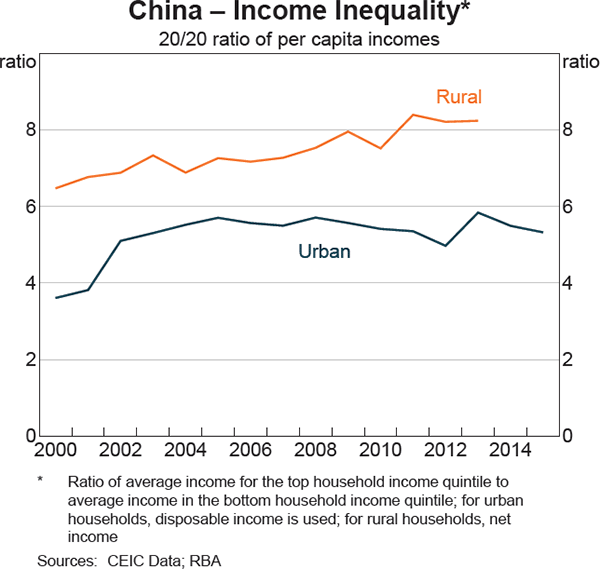
Saving Behaviour
To the extent that the propensity for households to save varies across the income distribution, income inequality also has implications for the level of, and changes in, aggregate saving. China's aggregate household saving rate appears to have risen notably over the past few decades. However, due to measurement challenges, there is some uncertainty about its precise level. One way to estimate the household saving rate is to use the flow-of-funds accounts, which are consistent with the national accounts on an income and expenditure basis. An alternative is to use data from the National Bureau of Statistics of China's (NBS) urban and rural household surveys. The two data sources measure income and consumption differently and both have potential sources of bias in the estimated saving rate. For example, the urban component of the household survey does not adequately sample rural–urban migrant workers even though they make up a considerable share of the urban population; to the extent that their income and consumption patterns differ from other urban households, the survey-based saving rate could be biased upward or downward.[7] In the flow-of-funds data, imputed rent is reportedly understated (Ma and Yi 2010; Koen et al 2013). Although including imputed rent will, all else being equal, reduce the estimated saving rate for owner-occupier households, understating imputed rent will result in a higher estimated saving rate than if imputed rent were measured correctly.
There has been a consistent difference in the levels of the two estimated aggregate saving rates over time. This is because estimated aggregate household consumption and income are both lower according to the household survey data, but income is lower by a greater margin, so the implied aggregate saving rate is lower. The flow-of-funds saving measure has also grown a little faster, reflecting slightly higher growth of household income than for the household survey measure. In contrast, although the levels of the consumption measures vary, their growth rates have been quite similar. Despite the differences between the two aggregate saving rate estimates, they both display a rising trend through the 1990s and 2000s, and both measures suggest that the household saving rate in China is high relative to other emerging or advanced economies (Graph 4).[8] China's high and rising household saving rate helped to support the strong growth of investment during the 1990s and 2000s (Ma, Roberts and Kelly 2016).
China's household saving rate has been studied extensively in the academic literature. There are a range of explanations for why it has been so high and rose over the 1990s and 2000s, including:
- Precautionary motives resulting from the income and employment uncertainty brought about by the transition to a more market-based economy, pension reform, the weakening of the social safety net, and a rising private burden of health and education expenses (Chamon, Liu and Prasad 2010; Meng 2003; Chamon and Prasad 2010; Blanchard and Giavazzi 2005; Ma and Yi 2010)
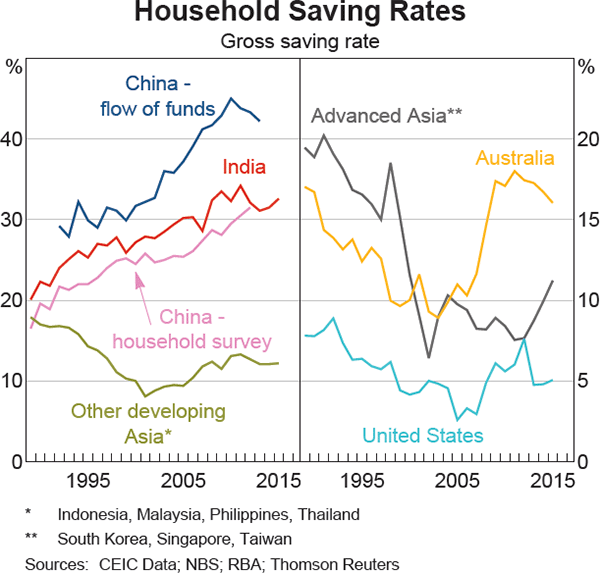
- Changes in China's demographic structure in combination with the life-cycle hypothesis. This may have increased household saving through the effects of ‘fewer mouths to feed’ (as the dependency ratio began to decline in the late 1970s) and the need for people to save for their old age (Modigliani and Cao 2004). China's one-child policy, a birthcontrol policy that encouraged couples to have one child only, influenced not only the dependency ratio, but also limited the role that family support could provide in old age, which could have encouraged saving by individuals
- Increases in the sex-ratio imbalance leading families with male children to increase savings to improve their son's chances in the face of rising competition in the marriage market (Wei and Zhang 2011)
- A desire to own housing (Blanchard and Giavazzi 2005; Chamon and Prasad 2010), as well as the strong increase in housing prices since the development of the private property market began (Ha 2006).
Despite the high aggregate household saving rate, there are notable variations in household saving behaviour by income level, with strong evidence that households' average propensity to save increases with income. All else being equal, this would suggest that the uneven distribution of the growth in household income may have also contributed to higher aggregate saving than otherwise. Cross-sectional urban household-level data from the 2000s suggest that there is a positive relationship between income and whether a household saves, and that some poorer households may have insufficient income to save. For example, a survey undertaken by the NBS in 2009 indicated that around 35 per cent of urban households in the lowest income decile did not save at all, while only 10 per cent of households in the top four income deciles did not save at all. In a separate survey, Gan (2013) found that almost half of Chinese households did not save at all in 2010.[9]
There is also considerable variation in the saving rate by income level, with higher-income households saving a greater proportion of their income (Graph 5). This pattern has persisted since the mid 1980s. The data suggest that wealthier rural households also save significantly more than their poorer rural counterparts. Despite these differences, all urban household income groups saw a rise in saving rates over the 2000s, and the share of urban households not saving declined from 23 per cent in 2002 to 16 per cent in 2009. The share of households with zero or negative saving rates is likely to continue to fall to the extent that real incomes continue to rise, particularly if some of those poorer households are currently liquidity constrained.
The heterogeneity in households' propensity to save suggests that, all else equal, a higher level of inequality in household income would reduce aggregate consumption more than otherwise (Gan 2013). In other words, the variation in saving behaviour also suggests that increasing the income of poorer households would have a positive effect on aggregate consumption and assist in the process of rebalancing to a domestic consumption-driven economy, as liquidity-constrained households would be likely to use at least some of the extra income to consume more (Gan 2013).
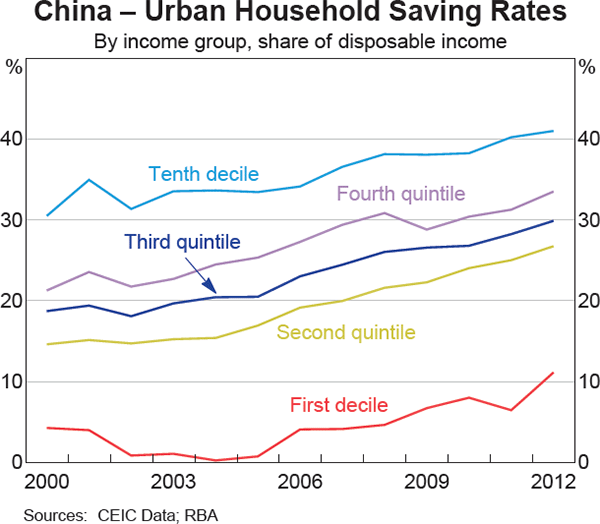
Changing Consumption Patterns
In addition to the distribution of household income affecting the level of aggregate consumption, it can also affect the composition of aggregate consumption. Notwithstanding the increase in China's aggregate saving rate over the past two decades, growth of real household consumption has still been persistently strong, averaging 9 per cent per annum. This pace of growth is very rapid compared with other economies. Since 1995, Chinese consumption growth has been, on average, nearly 2.5 percentage points higher than in India, 4.5 percentage points above that in other developing Asian economies and stronger still than in advanced economies (Graph 6). Even with this impressive growth, consumer spending per person in China remains low relative to many other economies, including economies with similar incomes per capita. Consumption per capita is only just over half the world average and less than one-fifth of that in Australia on a purchasing power parity basis (which accounts for differences in local living costs).
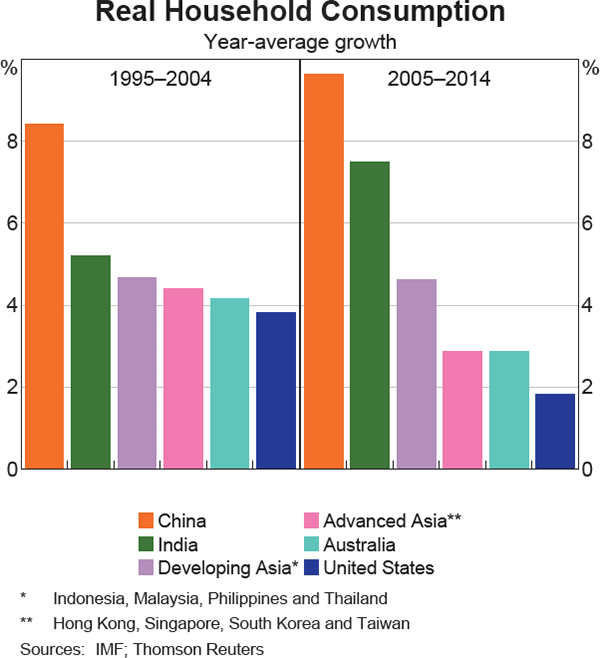
Growth in all types of consumer goods and services has contributed to the growth of Chinese household consumption in recent decades (Table 1). The composition of household spending, however, has changed significantly. In particular, the share of average household expenditure on food has declined from almost 60 per cent of total household consumption in the early 1980s to 30 per cent in 2015, and higher-income households spend a smaller share of expenditure on food than lower-income households (Table 2). Both of these observations are consistent with Engel's Law, which states that as income increases, the share of expenditure on food declines. Despite a decline in the share of food in total household expenditure, per capita food consumption and households' spending on food have been rising over time. Moreover, food consumption has shifted away from staples towards more protein-rich foods, such as dairy and meat (Graph 7).
Coinciding with these changes in the typical household consumption basket, transport and communication now account for a larger share of household spending, especially for higher-income households (Table 2).[10] Education and recreation and medical expenditures have also grown in importance. As higher-income households spend a greater share of their consumption basket on these more services-intensive expenditure categories, it is possible that increasing income inequality has provided some support to growth in aggregate consumption of these categories. As average incomes rise further, the share of expenditure on services is likely to continue to increase further.
| Component share, per cent |
Average annual growth, per cent |
||||
|---|---|---|---|---|---|
| 1993 | 2012 | 1993–2002 | 2003–12 | ||
| Food(b) | 50.1 | 36.2 | 7.8 | 12.4 | |
| Housing and household goods | 15.4 | 15.6 | 8.6 | 11.8 | |
| Clothing | 14.2 | 10.9 | 25.2 | 9.3 | |
| Recreation, education and culture | 9.2 | 12.2 | 25.6 | 14.6 | |
| Transport and communication | 3.8 | 14.7 | 18.6 | 9.0 | |
| Other | 7.2 | 10.3 | 18.1 | 8.7 | |
| Total | 100 | 100 | 8.9 | 10.7 | |
|
(a) Nominal consumption per capita Sources: CEIC Data; RBA |
|||||
| Low-income | Lower-middle-income | Middle-income | Upper-middle-income | High-income | |
|---|---|---|---|---|---|
| Food(b) | 43.2 | 40.9 | 38.6 | 35.8 | 33.2 |
| Housing and household goods | 10.9 | 11.5 | 11.2 | 11.2 | 10.7 |
| Clothing | 5.9 | 6.2 | 6.6 | 6.8 | 7.1 |
| Recreation, education and culture | 7.0 | 6.8 | 7.0 | 6.3 | 6.1 |
| Transport and communication | 9.9 | 11.3 | 13.1 | 14.9 | 16.7 |
| Other | 10.8 | 10.8 | 11.4 | 12.4 | 13.3 |
| Total | 100.0 | 100.0 | 100.0 | 100.0 | 100.0 |
|
(a) Low-income corresponds to the second income decile; lower-middle-income,
middle-income and upper-middle-income to the second, third and fourth
income quintiles; high-income corresponds to eighth decile Sources: CEIC Data; RBA |
|||||
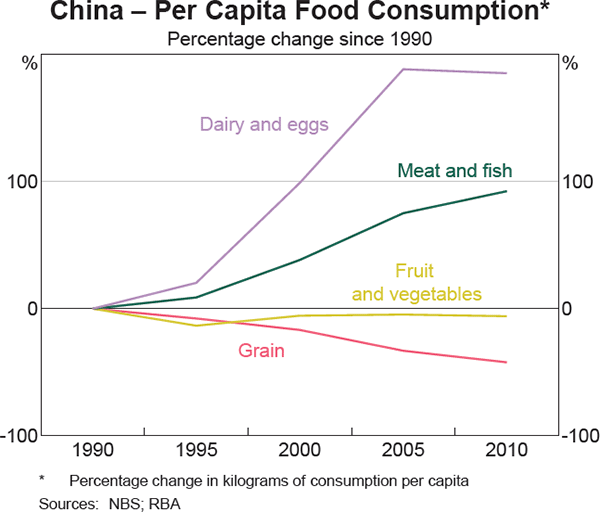
| 2003 $m | 2013 $m | Average annual growth 2003–13 Per cent | |
|---|---|---|---|
| Merchandise | 9,089 (81) | 94,344 (93) | 26 |
| Iron ore and concentrates | 1,739 (16) | 52,653 (52) | 41 |
| Coal, coke and briquettes | 243 (2) | 9,086 (9) | 44 |
| Food and live animals | 488 (4) | 3,145 (3) | 20 |
| Services | 2,068 (19) | 7,064 (7) | 13 |
| Travel | 1,733 (16) | 6,208 (6) | 14 |
| Total | 11,157 (100) | 101,408 (100) | 25 |
|
(a) Percentage shares of annual total in brackets Sources: ABS; RBA |
|||
Implications for China-Australia Bilateral Trade
Continued growth in Chinese household consumption will benefit economies that export to China, including Australia. The growth in Chinese household spending on services is already apparent in the rapid growth of imports of travel services from Australia (Table 3). Indeed, much of the growth in visitor arrivals to Australia in recent years has been driven by Chinese travellers and students. This is a trend that is likely to continue as the Chinese middle class grows (Dobson and Hooper 2015; RBA 2016).
While China is a net exporter of food, the trade surplus in food has narrowed significantly over the past five years and China has become a net importer of meat and dairy products. Further increases in the demand for food by China are likely to put pressure on domestic supply and could lead to further increases in imports. Australian exports of food to China have grown rapidly over the past few years. This growth has been driven by exports of cereals, meat and meat products. The gradual transition to higher meat consumption in China should support imports of meat, live animals and animal feed. Ongoing concerns around domestic food safety standards are also likely to contribute to demand for higher-value food imports such as dairy and organic produce (McCarthy, Liu and Chen 2015; Roberts et al 2016; FT Confidential 2016).
However, services and food account for only a small share of total exports from Australia to China. Even if growth of Australian services and food exports to China were to continue at the pace of the previous decade, it would take 13 years for the value of those exports to rise to the current combined value of iron ore and coal exports to China.[11] Moreover, in an environment of slowing economic growth in China, it is uncertain whether the levels of growth in Australia's services and food exports to China seen in the past decade can be maintained. Australia is also likely to have to compete more aggressively for Chinese imports of services and food. In the absence of a large-scale reorientation of bilateral trade patterns, the impact of any rebalancing in China from investment-driven to consumption-driven growth is, on balance, likely to be negative for demand for Australian exports, as Chinese investment is more import-intensive than consumption (Kelly 2014; Ma et al 2016).
Conclusion
Although Chinese household income and consumption have grown at a rapid pace in recent years, alongside a marked increase household saving rates, the outlook is uncertain. Household income growth is likely to slow alongside a general decline in the growth of Chinese economic activity, while the evolution of income inequality depends, at least in part, on the progress of hukou, social security and pension reforms. Although some progress has been made on these fronts, it is likely to take time before the rural–urban income gap narrows. To the extent that households' propensities to save and consume differ across the income distribution, reductions in income inequality could have implications for aggregate saving and consumption.
Precautionary motives for saving are likely to remain important in an environment of economic uncertainty. Also, households will still need to save for housing and other large expenditure items such as education and healthcare, unless public spending on the latter rises significantly. However, at the same time China's working-age population has started to decline – a trend that is expected to continue in coming years (Lim and Cowling 2016). This demographic shift is likely to put downward pressure on saving rates.
Chinese consumption per capita remains low relative to levels seen in other developing Asian economies, as well as advanced economies.[12] Although household incomes are likely to continue to grow over the long run, there could be volatility along the way as the economy rebalances. Growth in household incomes is vulnerable to the slowing of economic growth, and the path to higher levels of household consumption may not be a smooth one.
Nevertheless, if future income growth does lead to higher demand for service-intensive components of consumption, this should support Chinese demand for services imports, including from Australia. Exporters of agricultural commodities should also benefit as household food consumption shifts away from staples to higher-protein foods such as dairy and meat. However, services and food exports currently account only for a relatively small share of the total value of Australia's exports to China and would need to grow significantly to offset any future slowing in exports of key bulk commodities such as iron ore or coal.
Footnotes
Kate Stratford was in Economic Group during her secondment from the Bank of England. Arianna Cowling is from Economic Group. [*]
China's household saving rate can be calculated using data from household surveys or from flow-of-funds statistics. These are discussed later in this article. [1]
The Gini coefficient is a commonly used measure of inequality, which takes a value between zero and one, where zero represents complete equality and one represents complete inequality. For 1981 to 2001, we show estimates from Ravallion and Chen (2007), who use unpublished household income distribution tabulations from the National Bureau of Statistics of China (NBS) to construct an estimate of the Gini coefficient. For 2003 onwards, we use Gini coefficients published by the NBS; these are based on disposable income. All estimates are ultimately sourced from data collected by NBS household surveys. [2]
These figures are based on World Bank estimates of Gini coefficients by country. By way of comparison, the estimated Gini coefficients for Australia, the United States and India are 0.35, 0.41 and 0.34, respectively. [3]
The World Bank defines the poverty ratio as the percentage of the population living on less than US$1.90 a day in 2011 prices. [4]
The hukou system was introduced in the late 1950s to regulate population movements and, in particular, to control movement between rural and urban areas. Since the start of the reform era, restrictions on physical movement have been eased substantially, but a range of social welfare benefits continue to be attached to a household's formal residence status. [5]
As Wong (2013) notes, the San Nong (‘three rurals’) policies of the Hu Jintao–Wen Jiabao administration resulted in a large injection of fiscal resources into rural services, social security and income support schemes. [6]
It has also been claimed that there are various measurement problems with the NBS survey measures of household income and consumption. For example, Wang and Woo (2011) claim that wealthier households tend to under-report income. It has also been noted that the household survey consumption measure does not distinguish between current and capital expenditures, and so over-reports consumption (Kraay 2000). It is difficult to determine the net effect of these measurement issues on the household survey-based estimate of the aggregate saving rate. [7]
The household saving rate shown here for Australia is the gross saving rate rather than the net saving rate typically cited. The net saving rate adjusts for the consumption of fixed capital. [8]
This result was based on household-level data from the CHFS, which covers both urban and rural households. [9]
By way of comparison, in 2011 around one-quarter of Australian household spending was on food, tobacco and alcohol, around 15 per cent was on transport and communication, around 16 per cent on recreation, culture and education, and 4 per cent on clothing and footwear. [10]
Assuming that the total value of services, food and live animal exports from Australia to China continues to grow at the same average annual rate as for the period 2003 to 2013. Roberts et al (2016) construct scenarios for bilateral merchandise exports to China under alternative projections for Chinese growth. These scenarios similarly suggest that the share of food exports in bilateral trade is unlikely to overtake that of traditional resource commodities over the next two decades. [11]
Accounting for differences in local living costs, China's household consumption per capita is lower than in Indonesia, even though GDP per capita is higher; while Thailand's GDP per capita is only 20 per cent higher than China's, consumption per capita is more than 60 per cent higher. [12]
References
Blanchard O and F Giavazzi (2005), ‘Rebalancing Growth in China: A Three-Handed Approach’, Massachusetts Institute of Technology Department of Economics Working Paper Series 05–32.
Chamon M, K Liu and E Prasad (2010), ‘Income Uncertainty and Household Savings in China’, IMF Working Paper No WP/10/289.
Chamon M and E Prasad (2010), ‘Why are Savings Rates of Urban Households in China Rising?’, American Economic Journal: Macroeconomics, 2(1), pp 93–130.
Dobson C and K Hooper (2015), ‘Insights from the Australian Tourism Industry’, RBA Bulletin, March, pp 21–31.
FT Confidential (2016), ‘Brexit Stirs Chinese Household Fears about Global Economy’, FT.com site, 20 July. Available at <http://www.ft.com/cms/s/3/5b8985f6-4e68-11e6-8172-e39ecd3b86fc.html#axzz4EznTdGdN>.
Gan L (2013), ‘Income Inequality and Consumption in China’, Texas A&M University, unpublished manuscript.
Ha J (2006), ‘Understanding Household Consumption in China: The Role of Urbanization and Other Factors’, Hong Kong Institute for Monetary Research Conference, ‘Urbanisation and the Mainland Economy’, Hong Kong, 25 September.
Kelly G (2014), ‘Chinese Rebalancing and Australian Exports’, RBA Bulletin, December, pp 23–29.
Koen V, R Herd, X Wang and T Chalaux (2013), ‘Policies for Inclusive Urbanisation in China’, OECD, Economics Department Working Paper No 1090.
Kraay A (2000), ‘Household Saving in China’, World Bank Economic Review, 14 (3), pp 545–570.
Kuijs L and T Wang (2005), ‘China's Pattern of Growth: Moving to Sustainability and Reducing Inequality’, World Bank Policy Research Working Paper No 3767.
Lim J and A Cowling (2016), ‘China's Demographic Outlook’, RBA Bulletin, June, pp 35–42.
Ma G and W Yi (2010), ‘China's High Saving Rate: Myth and Reality’, BIS Working Paper No 312.
Ma, G, I Roberts and G Kelly (forthcoming), ‘A Rebalancing Chinese Economy: Challenges and International Implications’, Paper presented at the Reserve Bank of Australia Conference ‘Structural Change in China: Implications for Australia and the World’, Sydney, 17–18 March.
McCarthy BL, H Liu and T Chen (2015), ‘Trends in Organic and Green Food Consumption in China: Opportunities and Challenges for Regional Australian Exporters’, Journal of Economic and Social Policy, 17(1), Article 2.
Meng X (2003), ‘Unemployment, Consumption Smoothing, and Precautionary Saving in Urban China’, Journal of Comparative Economics, 31(3), pp 465–485.
Modigliani F and SL Cao (2004), ‘The Chinese Saving Puzzle and the Life-Cycle Hypothesis’, Journal of Economic Literature, 42(1), pp 145–170.
Park A (2008), ‘Rural–Urban Inequality in China’, in S Yusuf and T Saich (eds), China Urbanizes: Consequences, Strategies and Policies, East Asia Economic Prospects, The World Bank, Washington DC, pp 41–63.
Ravallion M and S Chen (2007), ‘China's (Uneven) Progress Against Poverty’, Journal of Development Economics, 82(1), pp 1–42.
RBA (Reserve Bank of Australia) (2016), ‘Box A: Australian Services Trade’, Statement on Monetary Policy, May, pp 36–38.
Roberts I, T Saunders, G Spence and N Cassidy (2016), ‘China's Evolving Demand for Commodities’, Paper presented at the Reserve Bank of Australia Conference ‘Structural Change in China: Implications for Australia and the World’, Sydney, 17–18 March.
Wang X and WT Woo (2011), ‘The Size and Distribution of Hidden Household Income in China’, Asian Economic Papers, MIT Press, 10(1), pp 1–26.
Wei S-J and X Zhang (2011), ‘The Competitive Saving Motive: Evidence from Rising Sex Ratios and Savings Rates in China’, Journal of Political Economy, 119(3), pp 511–564.
Wong C (2013), ‘Reforming China's Public Finances for Long-Term Growth’, in R Garnaut, F Cai and L Song (eds), China: A New Model for Growth and Development, China Update, ANU E Press, Canberra, pp 199–219.
Xie Y and X Zhou (2014), ‘Income Inequality in Today's China’, Proceedings of the National Academy of Sciences of the United States of America, 111(19), pp 6928–6933.
Zheng Y and M Chen (2007), ‘China's Regional Disparity and its Policy Response’, The University of Nottingham China Policy Institute Briefing Series Issue 25.